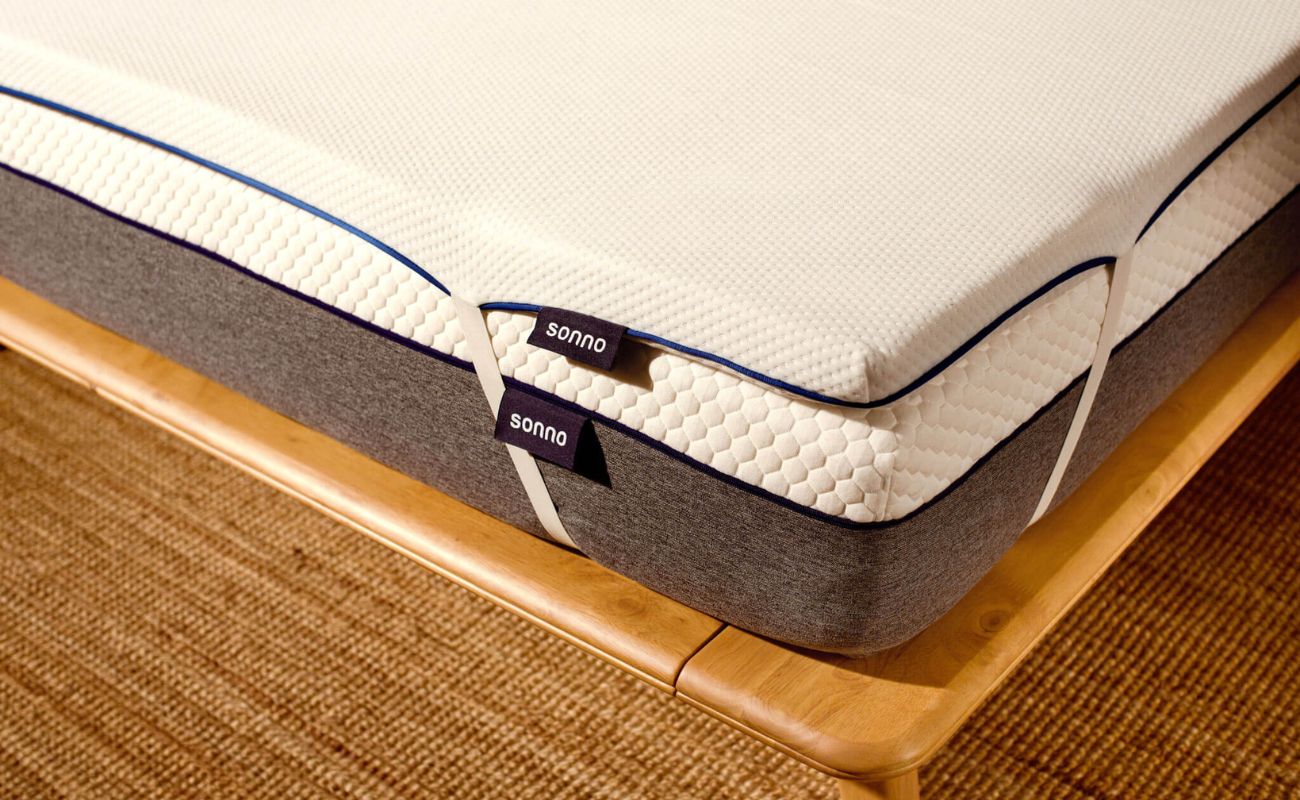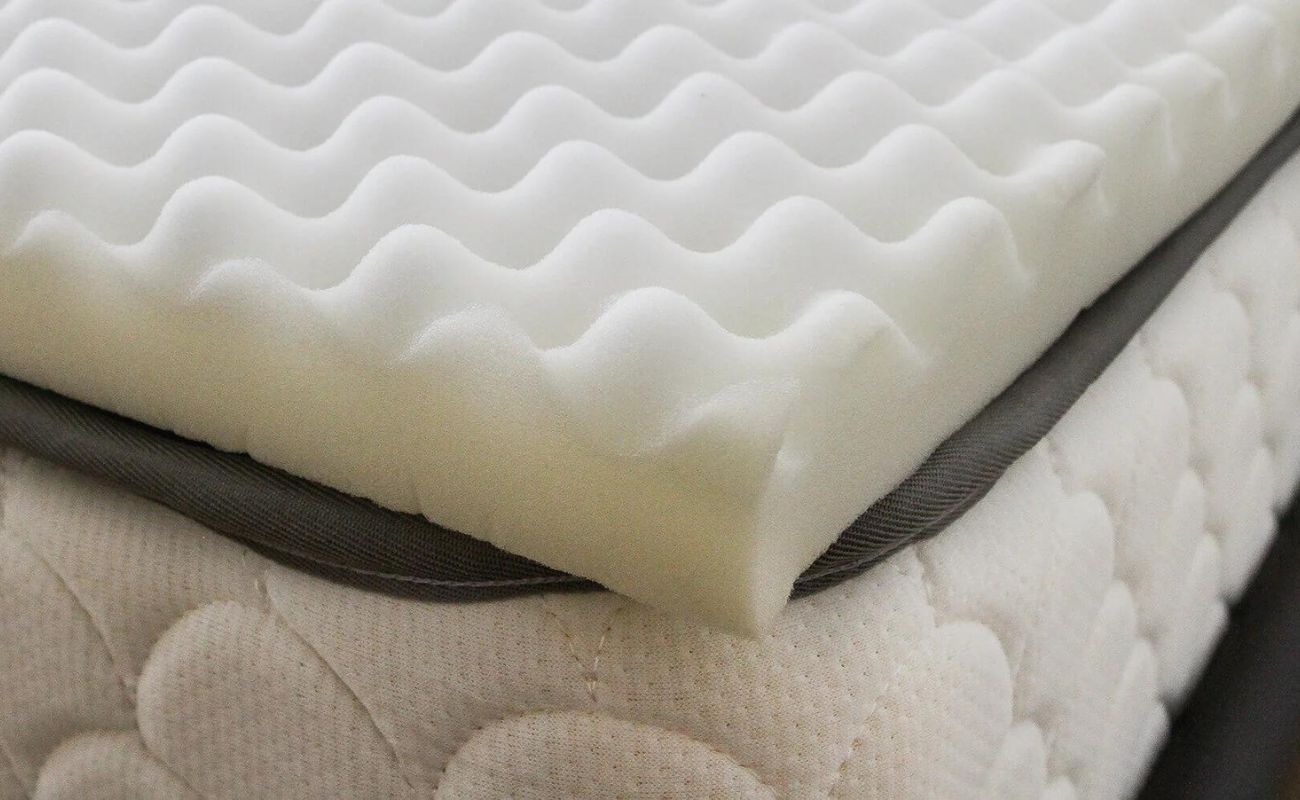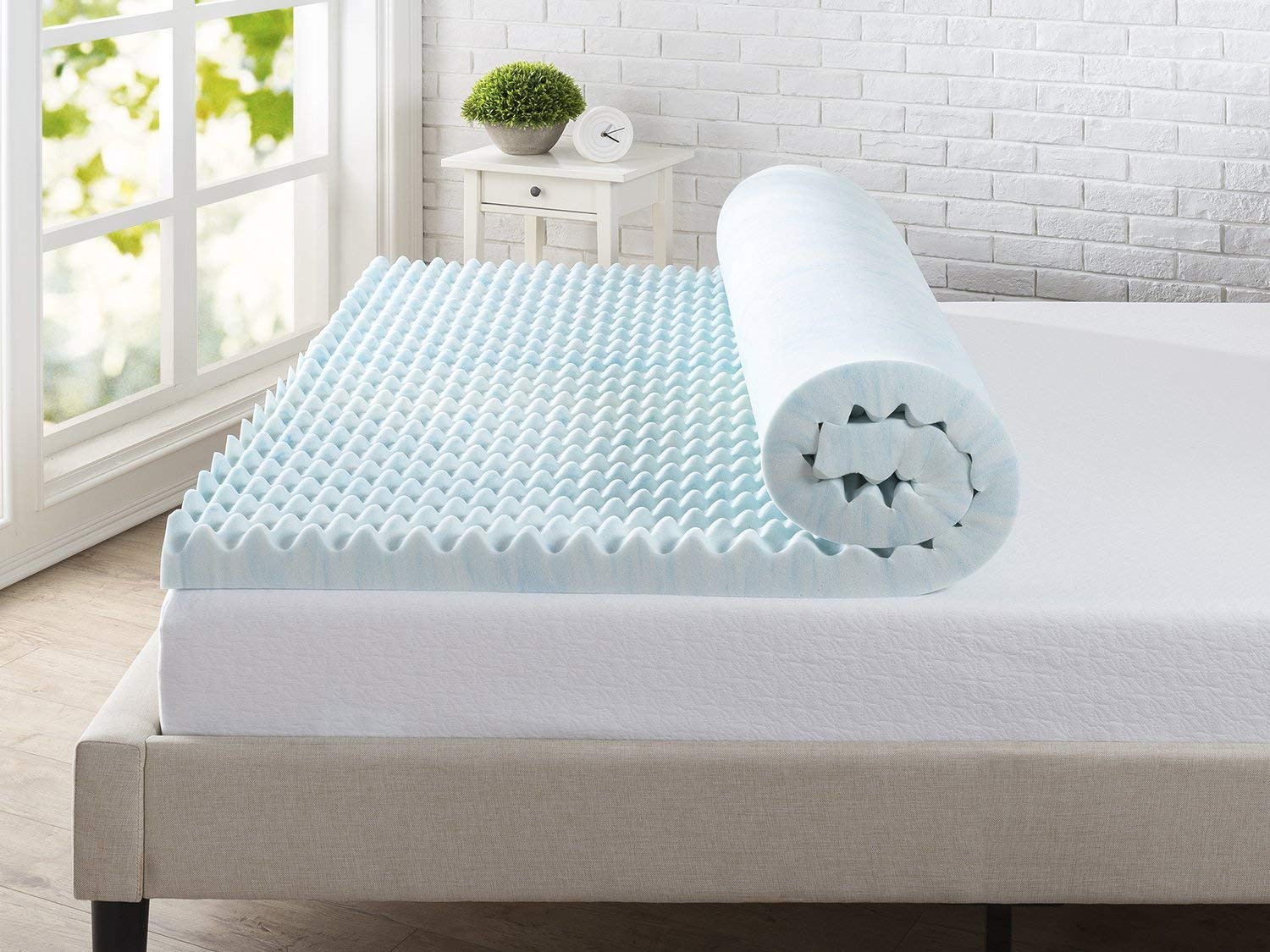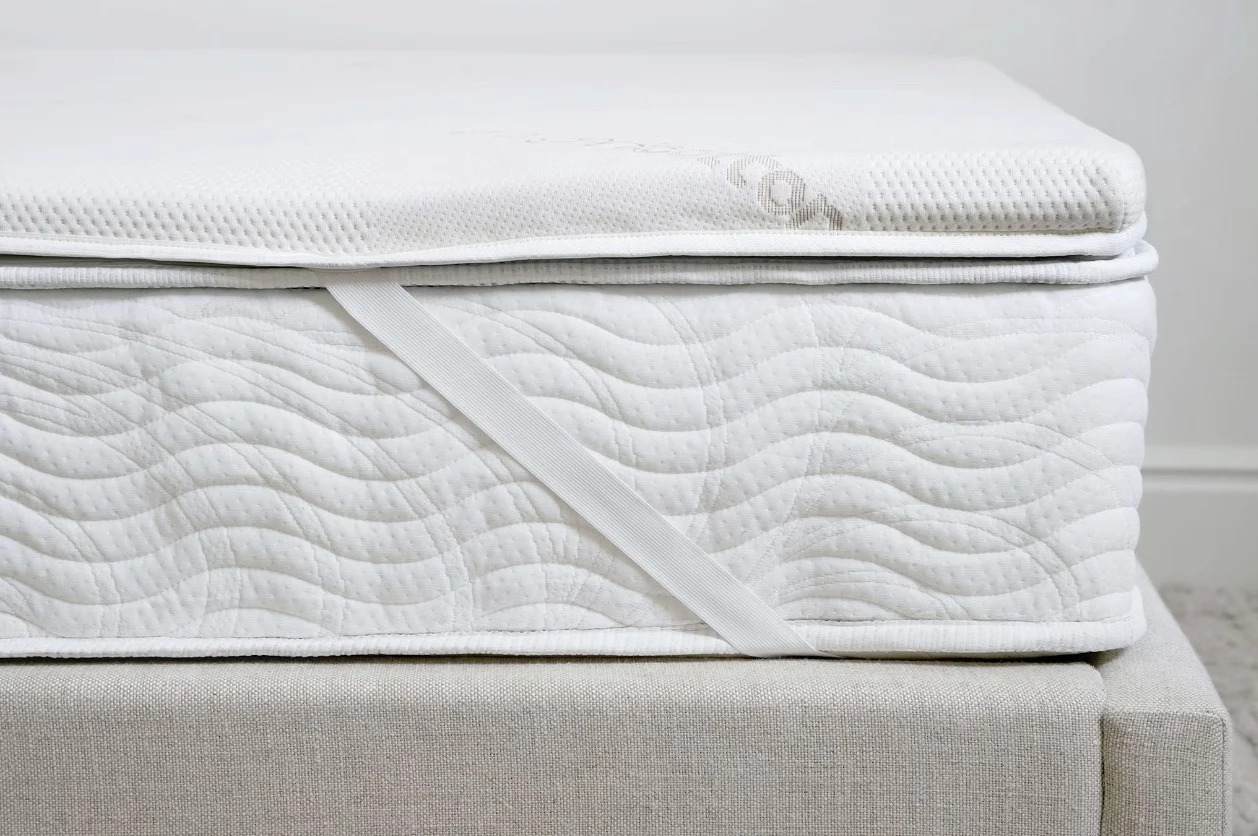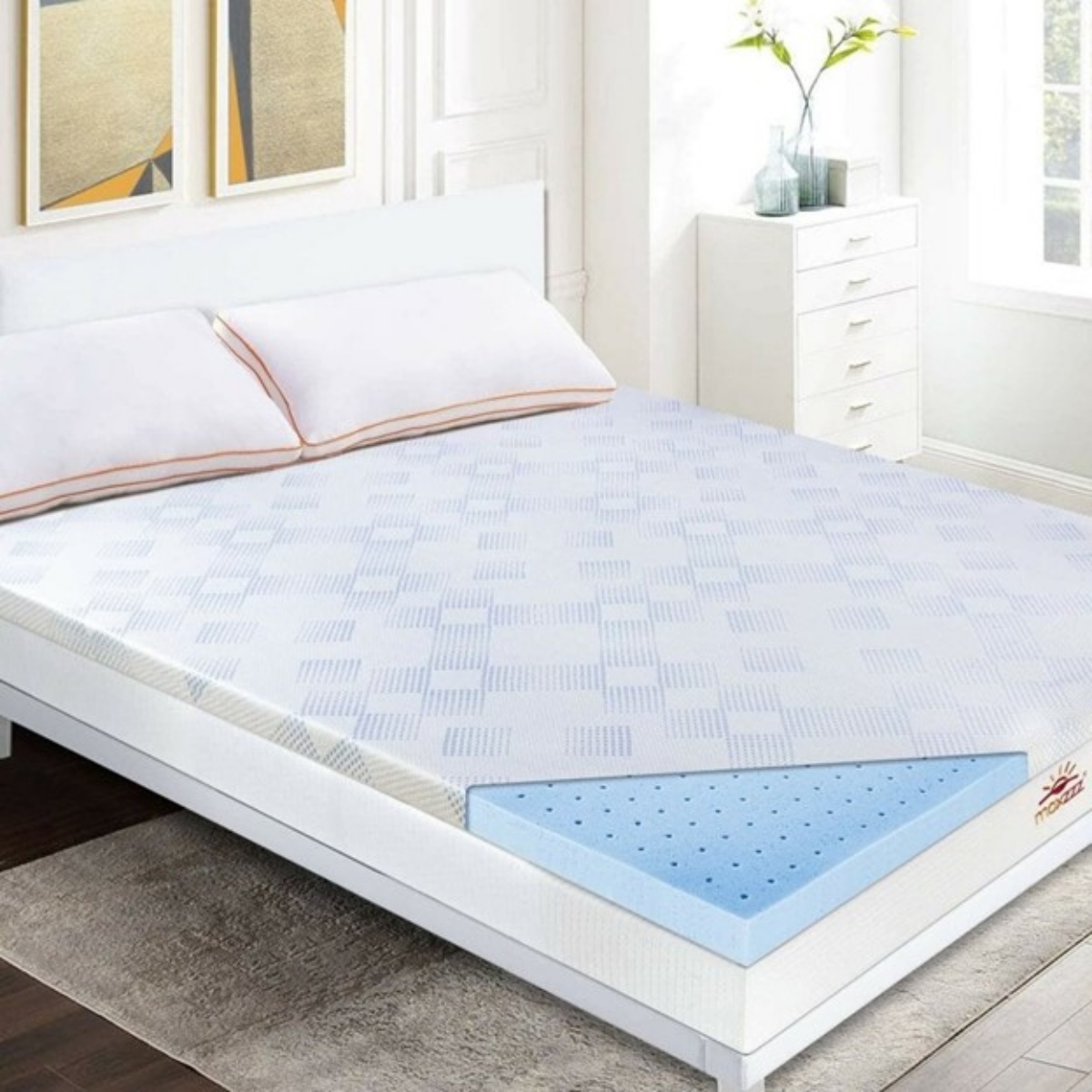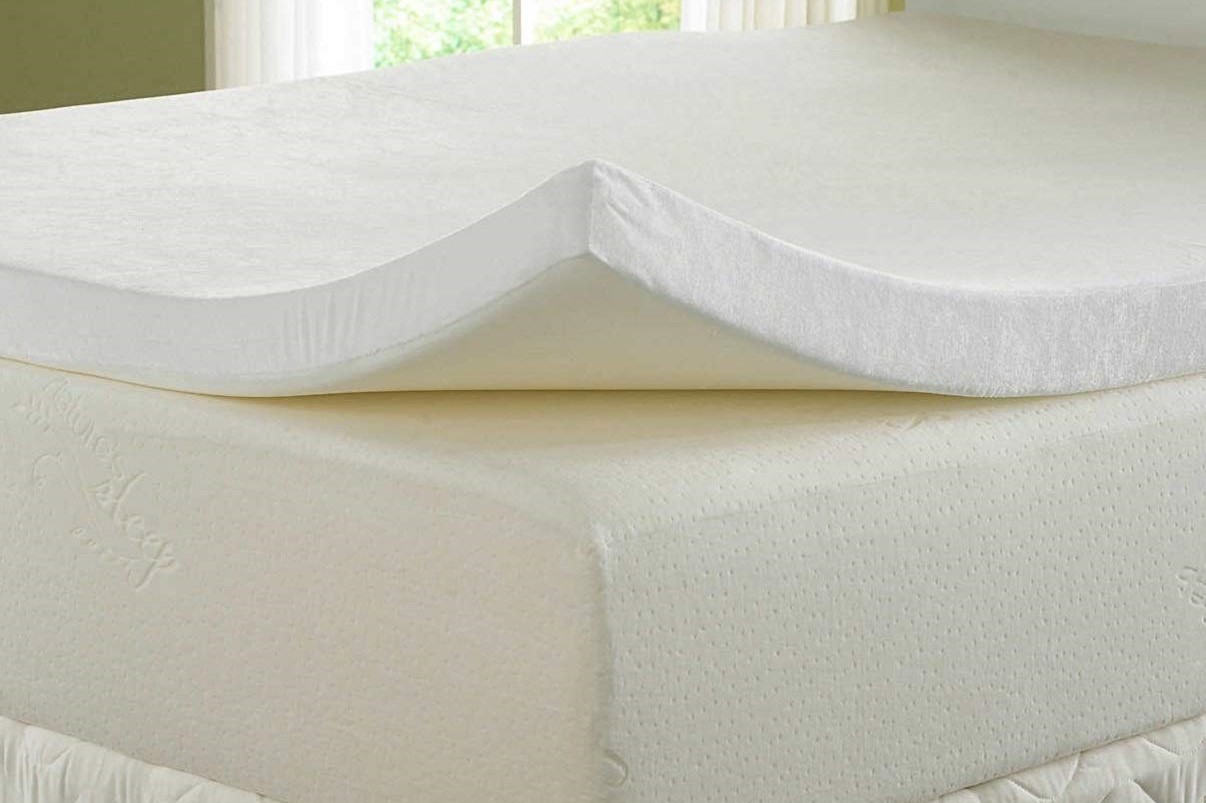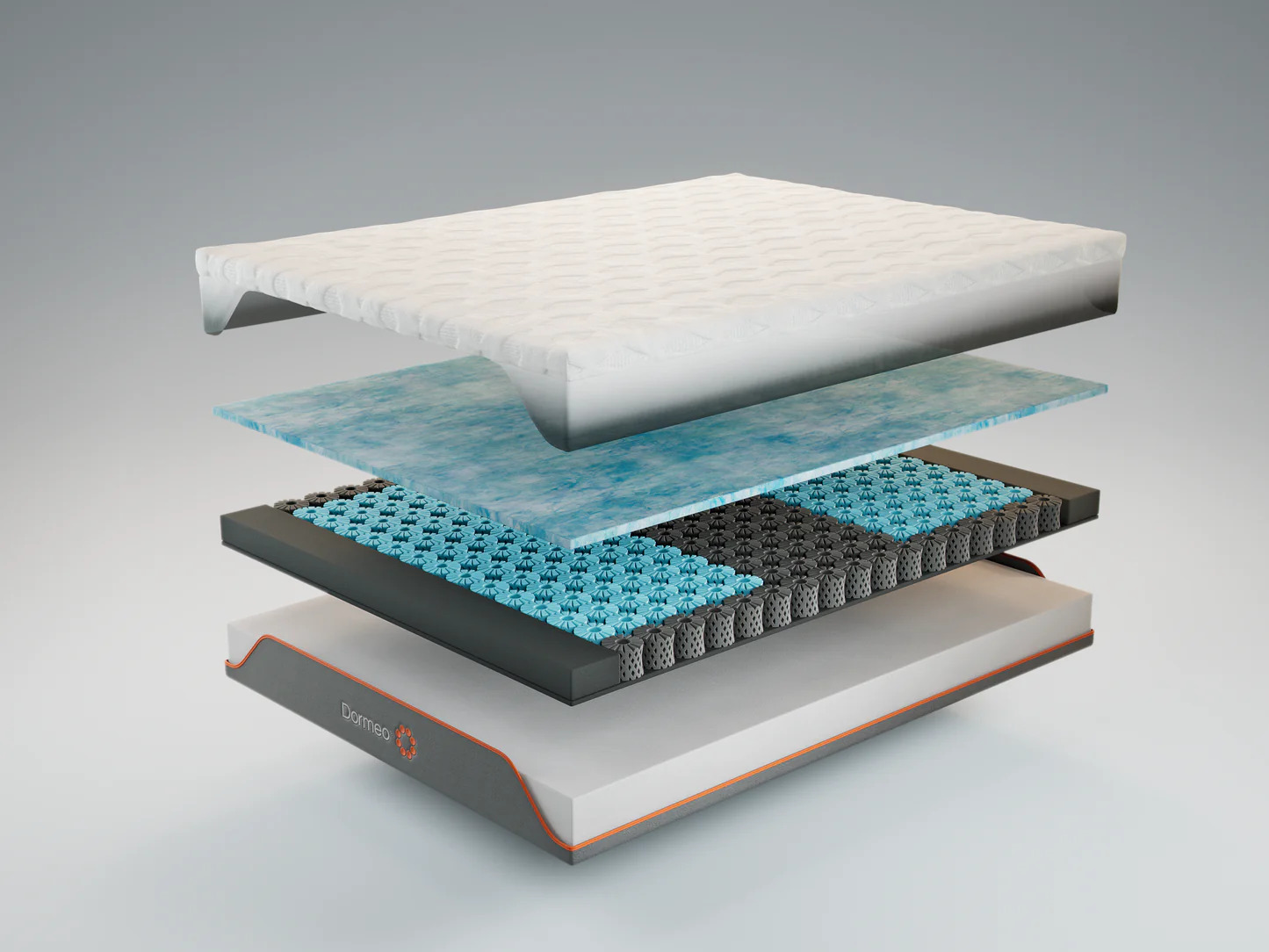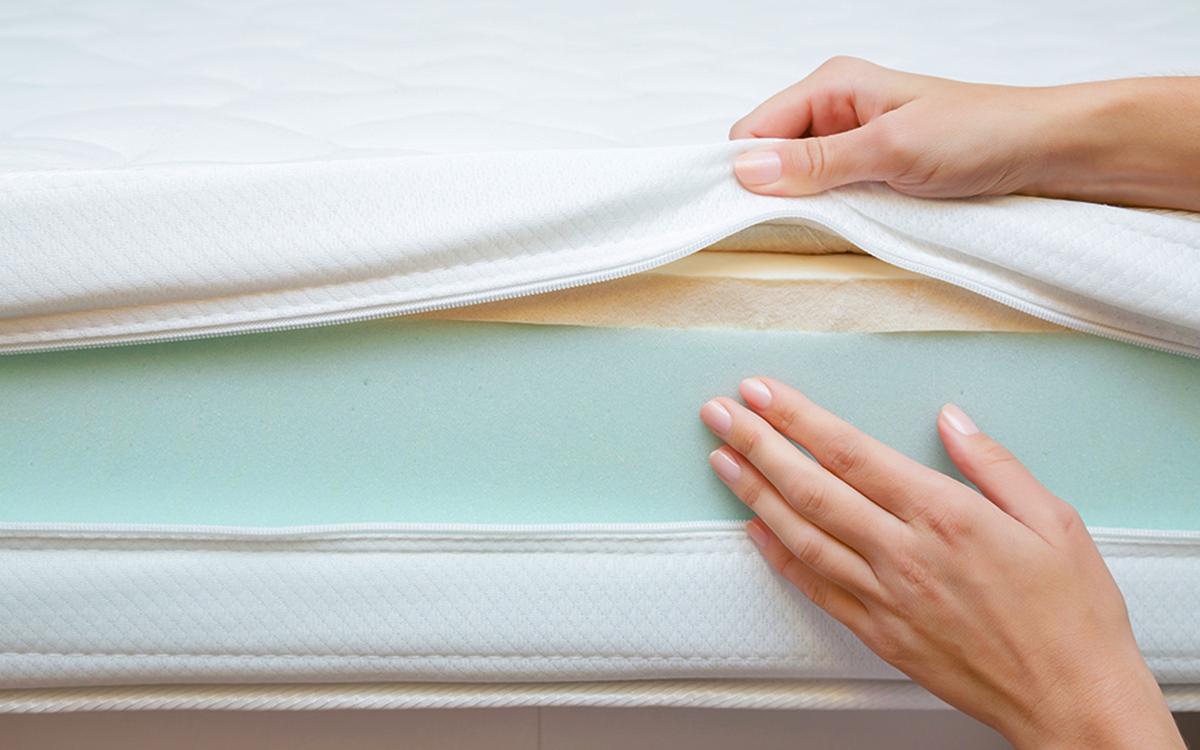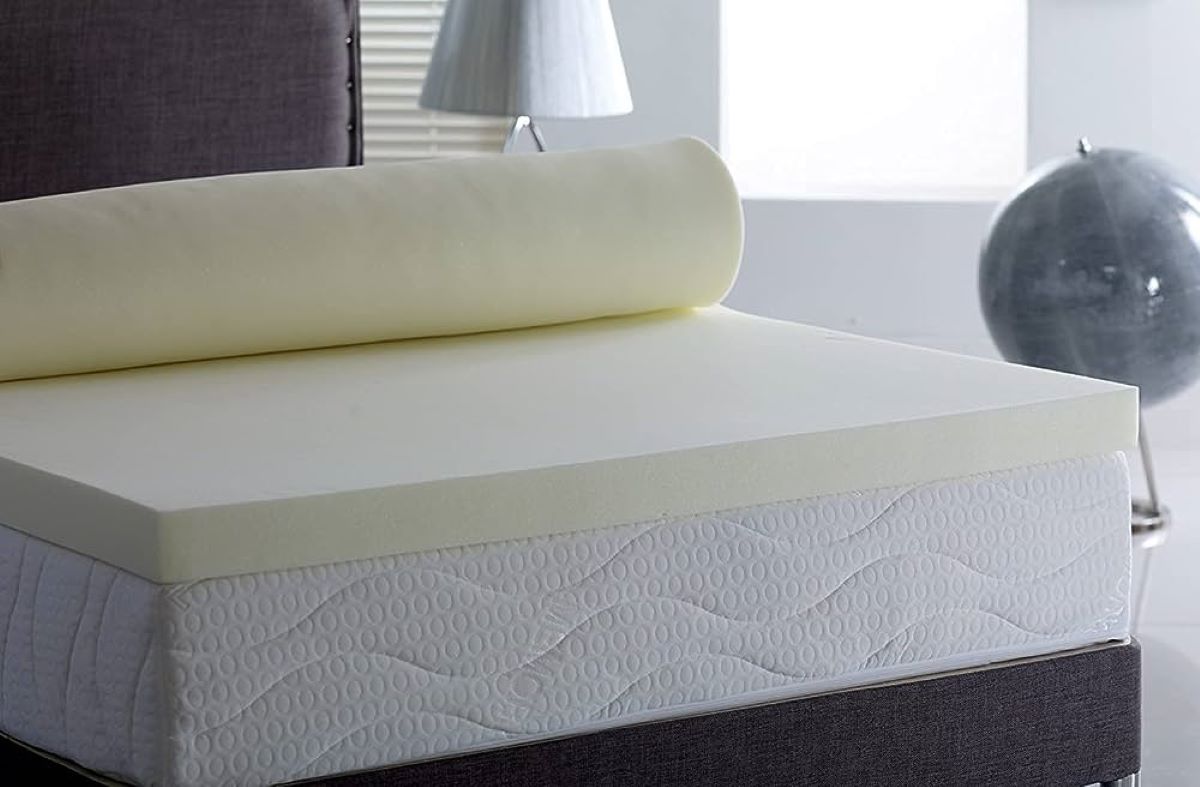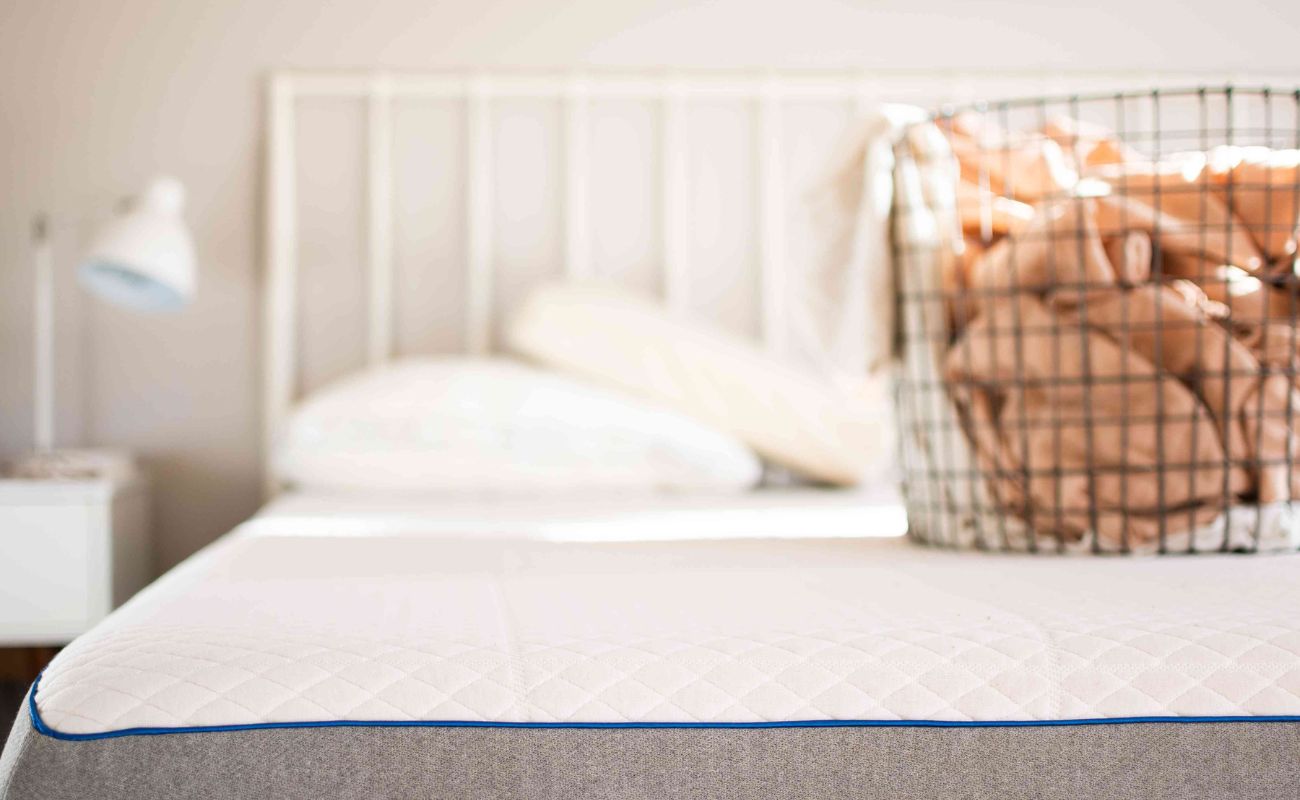Home>Furniture>Bedroom Furniture>Why Buy A Mattress Topper
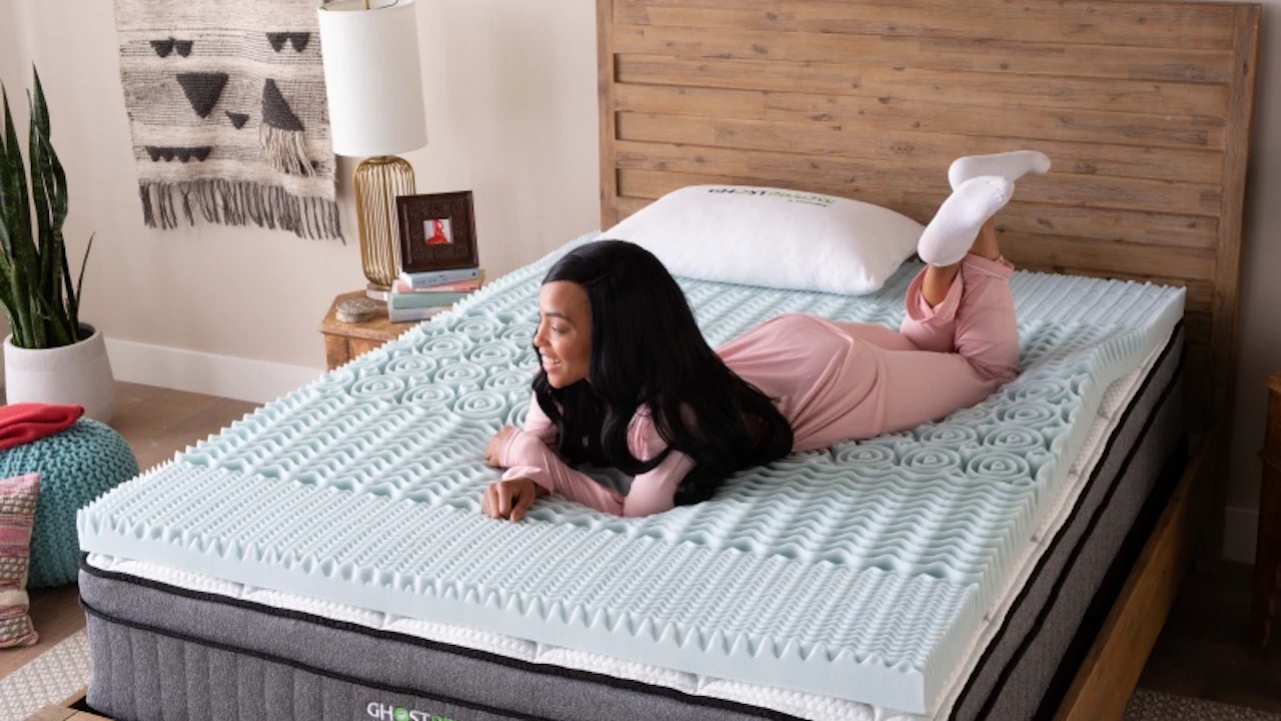

Bedroom Furniture
Why Buy A Mattress Topper
Modified: January 14, 2024
Looking for bedroom furniture? Upgrade your bed with a mattress topper for added comfort and support. Discover why buying a mattress topper is a worthwhile investment today.
(Many of the links in this article redirect to a specific reviewed product. Your purchase of these products through affiliate links helps to generate commission for Storables.com, at no extra cost. Learn more)
Introduction
When it comes to getting a good night”s sleep, the quality of your mattress plays a significant role. However, if your current mattress doesn”t provide the level of comfort and support you desire, investing in a mattress topper may be the solution you”ve been looking for.
A mattress topper is a removable layer that sits on top of your mattress, offering additional cushioning and support. It is typically made from materials such as memory foam, latex, feathers, wool, or down. In addition to increasing comfort, mattress toppers can also provide other benefits, such as improved pressure relief, temperature regulation, and allergen protection.
In this article, we will explore the various benefits of using a mattress topper, the different types available, and the key considerations to keep in mind when choosing the right one for your needs.
Key Takeaways:
- Enhance Your Sleep Experience
Choosing the right mattress topper can transform your sleep by providing personalized comfort, pressure relief, and temperature regulation, ensuring a restful and rejuvenating night’s sleep. - Consider Your Unique Needs
Assess your sleeping position, allergies, and desired features to select a topper that aligns with your preferences, promotes spinal alignment, and creates a healthier sleep environment.
Read more: Why Do Mattress Toppers Turn Yellow
Benefits of a Mattress Topper
Investing in a mattress topper can offer a range of benefits that can greatly enhance your sleep experience. Here are some of the key advantages of using a mattress topper:
- Improved Comfort and Support: One of the primary reasons people opt for mattress toppers is to enhance the comfort and support of their existing mattress. Toppers provide an extra layer of cushioning, relieving pressure points and ensuring a more comfortable sleep surface.
- Enhanced Pressure Relief: If you often wake up with aches and pains, a mattress topper can help alleviate pressure on sensitive areas of your body, such as your shoulders, hips, and back. This can lead to a more restful and pain-free sleep.
- Temperature Regulation: Some mattress toppers are designed with cooling properties, such as gel-infused memory foam or breathable materials. These toppers can help regulate your body temperature throughout the night, preventing overheating and promoting a cooler sleep environment.
- Allergen Protection: If you suffer from allergies or sensitivities, a mattress topper can act as a barrier between you and potential allergens, such as dust mites or pet dander. Look for hypoallergenic toppers that are resistant to allergens and easy to clean.
- Prolonged Mattress Lifespan: By adding a mattress topper to your bed, you can help extend the lifespan of your mattress. The topper acts as a protective layer, minimizing wear and tear on the underlying mattress and preventing sagging or indentations.
Whether you’re dealing with an uncomfortable mattress or simply looking to enhance your sleeping experience, a mattress topper can offer a range of benefits that will make a noticeable difference in the quality of your sleep. Now that we’ve explored the benefits, let’s delve into the different types of mattress toppers available.
Improved Comfort and Support
One of the primary reasons why people choose to invest in a mattress topper is to enhance the comfort and support of their existing mattress. Over time, mattresses can lose their original firmness or develop sagging areas, resulting in discomfort and poor sleep quality. A mattress topper provides an extra layer of cushioning and support, transforming your bed into a more comfortable sleep surface.
With a mattress topper, you can customize the feel of your bed to suit your preferences. If your mattress feels too firm, a plush topper can add a soft and cozy layer, allowing you to sink in slightly for a more cushioned feel. On the other hand, if your mattress is too soft or lacks support, a firmer topper can provide the necessary reinforcement to improve spinal alignment and reduce pressure points.
Memory foam mattress toppers are particularly popular for their ability to contour to your body’s shape, providing personalized support. The viscoelastic foam molds to your curves, relieving pressure on your joints and reducing the likelihood of waking up with stiffness or soreness. This added layer of comfort can make a significant difference, especially for those with chronic pain conditions or specific sleep needs.
Latex mattress toppers are another excellent option for enhanced comfort and support. They offer a responsive and buoyant feel, similar to memory foam, but with a bit more bounce. Latex toppers provide excellent pressure relief while still maintaining a supportive surface. The natural elasticity of latex allows for easy movement, making it suitable for those who prefer a more responsive sleep experience.
Regardless of the material you choose, a mattress topper can give you the sensation of sleeping on a brand-new mattress without the expense of actually replacing your current one. It can rejuvenate your bed’s comfort level, making it more inviting and conducive to a restful night’s sleep.
Next, we will explore another key benefit of using a mattress topper: enhanced pressure relief.
Enhanced Pressure Relief
Many individuals experience discomfort and pain when certain areas of their body, such as the shoulders, hips, and lower back, are subjected to excessive pressure while sleeping. This can result in restless nights and achy mornings. However, a mattress topper can provide enhanced pressure relief, alleviating these discomforts and promoting a more restful sleep.
Memory foam mattress toppers, in particular, excel at relieving pressure points due to their unique ability to contour to the shape of your body. The material responds to heat and pressure, allowing it to conform and mold to your body’s curves. This results in even weight distribution, reducing the pressure on specific areas and preventing the build-up of tension and pain.
When you lie down on a memory foam mattress topper, it cradles and supports your body, creating a cushioning effect that helps relieve pressure on your joints and muscles. By reducing pressure points, you can wake up feeling refreshed, with less stiffness and aches. This is especially beneficial for individuals who suffer from conditions such as arthritis or fibromyalgia, as well as those who have a tendency to toss and turn during the night.
Latex mattress toppers also offer excellent pressure relief while providing a more responsive sleep surface. The natural elasticity and resilience of latex allow it to conform to your body’s shape, providing cushioning and support without feeling overly soft. It evenly distributes your body weight, minimizing pressure on sensitive areas and promoting proper spinal alignment.
By investing in a mattress topper that offers enhanced pressure relief, you can significantly improve your sleep quality and overall well-being. Waking up free from pain and discomfort allows you to start your day on the right foot and feel more energized.
Now that we’ve discussed improved comfort and enhanced pressure relief, let’s move on to the next benefit of using a mattress topper: temperature regulation.
Temperature Regulation
Temperature plays a crucial role in the quality of your sleep. If you find yourself constantly feeling too hot or too cold at night, a mattress topper with temperature-regulating properties can help create a more comfortable sleeping environment.
Memory foam mattress toppers infused with cooling gel or other materials are specifically designed to dissipate heat and keep you cool throughout the night. The cooling gel absorbs and disperses body heat, preventing it from getting trapped in the foam. This helps regulate your body temperature, reducing the chances of overheating and promoting a more comfortable sleep.
Similarly, mattress toppers made from breathable materials, such as natural latex or ventilated foam, allow for better airflow. This prevents heat from being trapped between your body and the mattress, allowing for efficient heat dissipation and a cooler sleeping surface. The enhanced breathability helps you stay comfortable and avoid night sweats, even during warm summer nights.
Another option for temperature regulation is a mattress topper made from wool. Wool is known for its natural ability to regulate body temperature, keeping you warm in winter and cool in summer. It has moisture-wicking properties that draw perspiration away from your body, allowing it to evaporate and leave you feeling dry and comfortable.
By investing in a mattress topper that caters to temperature regulation, you can optimize your sleep environment and achieve a more consistent and comfortable sleep temperature. This can help prevent disturbances caused by night sweats or discomfort due to extreme heat or cold.
Now that we’ve explored the benefits of improved comfort, enhanced pressure relief, and temperature regulation, let’s move on to another advantage of using a mattress topper: allergen protection.
Read more: Who Sells Mattress Toppers
Allergen Protection
If you suffer from allergies or sensitivities, a mattress topper can provide an extra layer of protection against common allergens, helping to create a healthier and more comfortable sleep environment.
Dust mites, pet dander, pollen, and other allergens can accumulate in your mattress over time. These allergens can trigger allergic reactions, such as sneezing, coughing, itching, and congestion, making it difficult to get a good night’s sleep.
A mattress topper acts as a barrier, preventing allergens from settling into your mattress and coming into direct contact with your body. Look for mattress toppers that are hypoallergenic, resistant to dust mites, and have a tight weave that prevents allergens from penetrating the material.
Memory foam mattress toppers, in particular, are naturally resistant to dust mites and inhibit the growth of mold, bacteria, and other potential allergens. The dense structure of memory foam makes it difficult for these particles to penetrate the material, reducing the risk of allergic reactions.
It’s important to note that regular cleaning and maintenance are crucial in maintaining the allergen protection of your mattress topper. Vacuuming regularly and following the manufacturer’s instructions for cleaning and washing will help remove any accumulated allergens and keep your topper fresh and hygienic.
By using a mattress topper with allergen protection, you can create a healthier sleep environment that is free from potential allergens. This can significantly reduce your exposure to triggers and help alleviate symptoms, allowing you to sleep more peacefully and wake up feeling refreshed.
Now that we’ve discussed the benefits of improved comfort, enhanced pressure relief, temperature regulation, and allergen protection, let’s move on to another advantage of using a mattress topper: prolonged mattress lifespan.
Prolonged Mattress Lifespan
Your mattress is a significant investment, and you want it to last as long as possible. Using a mattress topper can help extend the lifespan of your mattress by providing an extra layer of protection.
Mattresses are subject to wear and tear over time, especially if they are regularly used. The continuous pressure from your body weight can cause the mattress to sag or develop indentations. This can lead to discomfort and a decrease in overall support.
By adding a mattress topper, you create an additional barrier between your body and the mattress. The topper absorbs some of the pressure and distributes it more evenly, reducing the strain on the underlying mattress. This helps to prevent sagging and indentation, keeping your mattress in better condition for a longer period.
Furthermore, mattress toppers are generally easier to clean than mattresses themselves. They can be spot cleaned or even machine washed, depending on the type of topper. This regular cleaning helps to prevent the buildup of dirt, dust, and stains, which can contribute to the degradation of the mattress over time.
It’s important to note that while a mattress topper can help prolong the lifespan of your mattress, it cannot completely reverse the effects of an old or worn-out mattress. If your mattress is already sagging significantly or causing persistent discomfort, it may be time to consider investing in a new mattress altogether.
By using a mattress topper to protect your mattress and keep it in better condition, you can maximize its lifespan and get the most out of your investment. It’s a cost-effective way to extend the life of your mattress while enjoying enhanced comfort and support.
Now that we’ve explored the benefits of improved comfort, enhanced pressure relief, temperature regulation, allergen protection, and prolonged mattress lifespan, let’s move on to the different types of mattress toppers available in the market.
Types of Mattress Toppers
When it comes to choosing a mattress topper, there are several options available, each with its own unique characteristics and advantages. Here are some of the most common types of mattress toppers:
- Memory Foam Toppers: Memory foam toppers are made from viscoelastic foam that conforms to your body’s shape, providing excellent pressure relief and support. They are known for their ability to contour to your curves, reducing motion transfer and minimizing disturbances from a sleeping partner.
- Latex Toppers: Latex toppers offer a responsive and supportive sleep surface. They are made from natural or synthetic latex, which is durable and resilient. Latex toppers provide a bit more bounce compared to memory foam, making them suitable for those who prefer a firmer and more responsive feel.
- Feather Toppers: Feather mattress toppers are made from soft feathers, typically from geese or ducks. They provide a plush and luxurious feel, and the feathers can be fluffed and rearranged to your desired comfort level. Feather toppers can add a cozy layer of warmth, making them ideal for colder climates.
- Wool Toppers: Wool mattress toppers are naturally breathable and regulate your body temperature effectively. They have moisture-wicking properties, keeping you cool in the summer and warm in the winter. Wool toppers provide a comfortable and hypoallergenic sleep surface.
- Down Toppers: Down toppers are made from the soft and fluffy undercoating of feathers. They offer excellent softness and comfort, providing a cloud-like sleeping experience. Down toppers are lightweight and offer good insulation, but they may need regular fluffing to maintain their loftiness.
- Cooling Toppers: Cooling mattress toppers are specially designed to regulate body temperature and prevent overheating during sleep. They can be made from materials like gel-infused memory foam or ventilated foam, which helps improve airflow and dissipate heat more efficiently.
When choosing a mattress topper, consider your personal preferences, sleep needs, and any specific requirements you may have, such as allergies or sensitivity to certain materials. Each type of topper offers different features, so take the time to research and find the one that best suits your needs.
Now that we’ve explored the various types of mattress toppers available, let’s move on to the important considerations you should keep in mind when choosing the right topper for you.
Memory Foam Toppers
Memory foam mattress toppers have gained immense popularity in recent years, thanks to their ability to provide exceptional comfort and support. These toppers are made from viscoelastic foam, a special type of foam that responds to temperature and pressure. Here’s what you need to know about memory foam toppers:
Conforming Support: Memory foam toppers are renowned for their excellent contouring properties. When you lie down on a memory foam topper, it molds to the shape of your body, offering personalized support. This contouring effect helps reduce the pressure on your joints, relieving pain and promoting a more comfortable sleep experience.
Pressure Relief: One of the standout benefits of memory foam toppers is their ability to provide enhanced pressure relief. The foam evenly distributes your body weight, ensuring that no single point bears excessive pressure. By reducing pressure points, memory foam toppers can help alleviate discomfort and improve circulation, allowing you to wake up feeling refreshed and rejuvenated.
Motion Isolation: Memory foam has excellent motion isolation properties, which means it absorbs the movements you or your partner make during the night, minimizing disruptions. If you share the bed with a restless sleeper, a memory foam topper can help ensure a more peaceful sleep environment.
Durability: High-quality memory foam toppers are known for their durability. They can withstand everyday use without losing their shape or supportive properties. However, it’s important to note that the longevity of a memory foam topper depends on its density. Higher density foams tend to last longer but may be firmer.
Temperature Sensitivity: Traditional memory foam has the reputation of retaining heat, which can be uncomfortable for some sleepers. However, new advancements in memory foam technology have led to the development of gel-infused or open-cell foams that offer better breathability and improved temperature regulation. If you tend to sleep hot, consider opting for a memory foam topper with cooling properties.
Care and Maintenance: Memory foam toppers are generally low maintenance. Regularly rotating the topper can help prevent sagging and promote even wear. Spot cleaning with a mild detergent or enzyme-based cleaner is usually sufficient for maintaining cleanliness. Additionally, using a waterproof mattress protector can protect the topper from spills and stains.
Memory foam mattress toppers are a popular choice for those seeking a balance of comfort and support. However, it’s important to choose the right density and thickness to suit your preferences and sleeping position. Factors such as body weight, sensitivity to heat, and individual preferences should also be considered when selecting a memory foam topper.
Now that we’ve explored memory foam toppers, let’s move on to another popular type: latex toppers.
Read more: How To Store A Mattress Topper
Latex Toppers
Latex mattress toppers have gained a loyal following due to their natural responsiveness, comfort, and durability. Made from the sap of rubber trees, latex toppers offer a unique sleep experience that appeals to a wide range of sleepers. Here’s what you need to know about latex toppers:
Responsive Support: Latex toppers are known for their excellent responsiveness. They offer a balance of support and contouring that ensures proper spinal alignment and reduces pressure points. The natural elasticity of latex allows it to respond to your movements, providing support where you need it most.
Natural and Hypoallergenic: Latex is inherently hypoallergenic and resistant to dust mites, mold, and mildew. This makes latex toppers an excellent choice for individuals with allergies or sensitivities. The natural materials used in latex toppers also contribute to their eco-friendly appeal.
Breathability and Temperature Regulation: Latex has open-cell structure, which allows for excellent airflow and breathability. This helps dissipate heat and moisture, keeping you cool and dry throughout the night. Latex toppers are a great option for those who tend to sleep hot or live in warmer climates.
Durability: Latex toppers are highly durable and have a longer lifespan compared to many other types of toppers. The natural resilience of latex allows it to withstand compression and retain its shape over time. A high-quality latex topper can last for many years, providing consistent support and comfort.
Responsiveness and Motion Isolation: Latex toppers have a unique bounce that offers a responsive sleep surface. This makes it easier to change positions during the night and can be particularly beneficial for combination sleepers. Additionally, the natural properties of latex help isolate motion, reducing disturbances caused by a restless sleeping partner.
Considerations: Latex toppers come in different firmness levels, so it’s important to choose one that aligns with your preferred level of support. Talalay latex is known for its softness and luxurious feel, while Dunlop latex is denser and provides firmer support. Also, keep in mind that latex toppers may have a unique odor initially, but it tends to dissipate within a few days.
Latex toppers offer a combination of comfort, support, and natural materials that many sleepers find appealing. Whether you prefer a soft, plush feel or a firmer surface, latex toppers can provide the right level of support to enhance your sleep experience.
Now that we’ve explored latex toppers, let’s move on to another popular type: feather toppers.
Feather Toppers
Feather mattress toppers are a luxurious and indulgent option for those seeking a soft and plush sleep surface. Made from the feathers of geese or ducks, these toppers provide a cozy and cloud-like feel that enhances the comfort of your mattress. Here’s what you need to know about feather toppers:
Supreme Softness: Feather toppers are renowned for their unmatched softness and plushness. The combination of feathers and down creates a fluffy and cushiony layer that feels incredibly comfortable to sleep on. The topper gently cradles your body, providing a cozy and inviting sleep surface.
Customizable Comfort: Feather toppers offer the advantage of being highly customizable. The feathers can be fluffed and rearranged to your desired comfort level. This allows you to adjust the loft and softness of the topper based on your preferences, making it suitable for a wide range of sleepers.
Excellent Insulation: Feather toppers offer excellent insulation, making them an ideal choice for colder climates or individuals who feel chilly during the night. The layers of feathers trap air, creating an effective thermal barrier that helps to retain warmth throughout the night.
Lightweight and Breathable: Despite their luxurious feel, feather toppers are lightweight and breathable. The natural fibers allow for good airflow, preventing the build-up of heat and moisture. This helps to regulate your body temperature and keep you cool during warmer seasons.
Considerations: It’s important to note that feather toppers may not provide the same level of support as other types of toppers. They are primarily designed to enhance the softness and comfort of your mattress. Feather toppers also require regular fluffing to maintain their loftiness and prevent the feathers from clumping. Additionally, individuals with allergies may want to consider hypoallergenic alternatives, as feathers can potentially trigger allergies.
Feather toppers provide a luxurious and indulgent sleep experience, enveloping you in softness and comfort. If you prefer a plush and cozy sleeping surface, a feather topper can transform your bed into a haven of relaxation.
Now that we’ve explored feather toppers, let’s move on to another popular type: wool toppers.
When buying a mattress topper, consider the material and thickness that best suits your needs. Memory foam toppers provide pressure relief, while latex toppers offer more resilience and support. Thicker toppers are better for heavier individuals or those who want extra cushioning.
Wool Toppers
Wool mattress toppers offer a unique combination of comfort, breathability, and natural temperature regulation. Made from the wool of sheep, these toppers provide a cozy and cozy sleep surface that is favored by many sleepers. Here’s what you need to know about wool toppers:
Natural Temperature Regulation: Wool is a natural insulator, making wool toppers ideal for year-round use. Wool has the unique ability to regulate your body temperature, keeping you warm in colder months and cool in warmer seasons. This natural temperature regulation helps ensure a comfortable sleep environment.
Moisture-Wicking Properties: Wool has excellent moisture-wicking properties, helping to keep you dry throughout the night. It can absorb moisture from your body and release it into the surrounding environment. This means that even if you tend to sweat during sleep, a wool topper can help keep you comfortable by preventing the accumulation of moisture.
Softness and Cushioning: Wool toppers offer a gentle and soft sleeping surface. They provide a luxurious and plush feel that adds an extra layer of comfort to your mattress. The natural loft and resilience of wool ensure that the topper retains its shape and continues to offer cushioning support over time.
Hypoallergenic Properties: Wool is naturally resistant to dust mites, mold, and mildew, making wool toppers a good choice for individuals with allergies or sensitivities. The fibers of wool are less likely to harbor allergens, creating a cleaner and healthier sleep environment.
Considerations: Wool toppers may have a distinct odor initially, although it typically dissipates within a few days. Some individuals may find the natural resilience of wool to be different from the sink-in feel of memory foam or the bounce of latex. It’s important to choose a wool topper with the right thickness to ensure the desired level of comfort and support.
Wool toppers offer a cozy and comfortable sleep experience, providing natural temperature regulation and moisture-wicking properties. If you’re looking for a versatile and hypoallergenic option that keeps you cool in the summer and warm in the winter, a wool topper can be an excellent choice.
Now that we’ve explored wool toppers, let’s move on to another popular type: down toppers.
Down Toppers
Down mattress toppers are known for their luxurious softness and exceptional comfort. Filled with the soft and fluffy undercoating of feathers, down toppers offer a cloud-like sleep experience. Here’s what you need to know about down toppers:
Sumptuous Softness: Down toppers are unmatched in their plushness and softness. The soft feathers provide a gentle and comforting cushioning effect that cradles your body. The resulting sleeping surface is incredibly cozy and inviting, reminiscent of sleeping on a fluffy cloud.
Lightweight and Breathable: Despite their lofty appearance, down toppers are lightweight and breathable. The natural properties of down allow for good airflow and help regulate your body temperature throughout the night. This ensures that you stay comfortable and cool, even during warmer seasons.
Customizable Comfort: Down toppers offer a level of customization as they can be fluffed and rearranged to suit your preference. This allows you to adjust the loftiness and softness of the topper according to your individual comfort needs, providing a personalized sleep experience.
Excellent Insulation: Down has excellent insulating properties, making down toppers an ideal choice for colder climates or individuals who are more sensitive to cold. The layers of down trap warm air, creating a cozy and warm sleeping surface that helps retain heat for a comfortable night’s sleep.
Considerations: While down toppers provide exceptional softness, they may not offer the same level of support as foam or latex toppers. It’s important to consider your personal comfort preferences and sleep needs when choosing a down topper. Additionally, some individuals may be allergic to down or feathers, so it’s essential to ensure you’re not sensitive to these materials before considering a down topper.
Down toppers offer a luxurious and indulgent sleep experience, enveloping you in softness and comfort. If you’re looking for a topper that provides a plush and cozy sleeping surface, down toppers are an excellent choice.
Now that we’ve explored down toppers, let’s move on to another popular type: cooling toppers.
Read more: What To Look For In A Mattress Topper
Cooling Toppers
When it comes to staying cool and comfortable throughout the night, cooling mattress toppers are a popular choice. Designed to regulate body temperature and prevent overheating, these toppers offer a refreshing and comfortable sleep experience. Here’s what you need to know about cooling toppers:
Gel-Infused Memory Foam: One common type of cooling topper is the gel-infused memory foam. These toppers are made by infusing cooling gel beads into the memory foam, which helps dissipate heat and regulate body temperature. The gel absorbs and disperses heat, keeping you cool throughout the night.
Ventilated Foam: Another type of cooling topper is made from ventilated foam. These toppers feature a construction with evenly spaced airflow channels that promote breathability. The enhanced airflow helps in dissipating heat, allowing for a cooler sleep surface.
Natural Cooling Materials: Some cooling toppers are made from natural materials that have inherent cooling properties. For example, bamboo- or cotton-based toppers offer excellent breathability and moisture-wicking capabilities, keeping you cool and dry throughout the night.
Moisture Absorption: Cooling toppers often offer moisture absorption properties, drawing away sweat and moisture from your body. This helps prevent the accumulation of moisture, keeping you comfortable and preventing that sticky, overheated feeling during sleep.
Enhanced Airflow: The design of cooling toppers prioritizes enhanced airflow to promote a cooler sleep environment. This helps to prevent the buildup of heat and allows for better ventilation, keeping you comfortably cool during the night.
Considerations: While cooling toppers are designed to regulate temperature, their effectiveness may vary based on factors such as room temperature, personal preferences, and individual body heat. It’s important to choose a cooling topper based on your unique needs and preferences, taking into consideration other factors such as support and comfort.
Cooling mattress toppers are a great option for those who tend to sleep hot or live in warmer climates. By helping to regulate body temperature and creating a cooler sleep environment, these toppers can significantly enhance your comfort and promote a more restful night’s sleep.
Now that we’ve explored cooling toppers, let’s move on to the important considerations to keep in mind when choosing the right mattress topper for you.
Considerations When Choosing a Mattress Topper
When selecting a mattress topper, several important factors should be taken into consideration to ensure you choose the right one for your needs. Here are key considerations to keep in mind:
Thickness and Density: The thickness and density of the topper will affect its level of support and comfort. Thicker toppers generally provide more cushioning, while denser toppers offer enhanced support. Consider your personal preferences and any specific comfort or support needs you may have.
Firmness Level: Different toppers have varying firmness levels. Some are designed to add softness to a firm mattress, while others offer a more supportive feel. Think about your preferred level of firmness and select a topper that complements the feel of your existing mattress.
Sleeping Position: Your preferred sleeping position can influence the type of topper that will work best for you. For example, side sleepers may benefit from a plush topper that provides extra cushioning for the shoulders and hips, while back or stomach sleepers may prefer a firmer topper for spinal alignment.
Allergies and Sensitivities: If you have allergies or sensitivities, consider a hypoallergenic mattress topper that is resistant to dust mites, mold, and allergens. Natural materials like latex or wool can be a good choice for those seeking hypoallergenic options.
Durability and Maintenance: Consider the durability and maintenance requirements of the topper. Some materials may be more prone to wear and tear than others, and certain toppers may require regular fluffing or specialized cleaning methods. Evaluate the upkeep needed to keep the topper in good condition over time.
Budget: Set a budget for your mattress topper purchase. Toppers come in a wide range of price points, so it’s important to establish a budget that aligns with your financial considerations. Remember that investing in a high-quality topper can offer long-term benefits and enhanced sleep comfort.
By considering these factors, you can make an informed decision and choose a mattress topper that meets your specific needs. Assessing key aspects such as thickness, firmness, sleeping position compatibility, allergies, durability, and budget will help ensure a successful selection.
Now that we’ve discussed the key considerations, let’s move on to how to choose the right mattress topper for you.
Thickness and Density
When choosing a mattress topper, the thickness and density play a crucial role in determining the level of support and comfort it provides. Here’s what you need to know about thickness and density when selecting a topper:
Thickness: The thickness of a mattress topper refers to the height or depth of the topper. Toppers generally range from 1 to 4 inches in thickness. Thicker toppers tend to offer more cushioning and can significantly change the feel of your mattress. They are an excellent choice if you prefer a plush and luxurious sleeping surface or if you have a mattress that is too firm for your liking. Thinner toppers, on the other hand, provide a subtle adjustment and are ideal if you are looking for a slight enhancement in comfort without dramatically changing the feel of your mattress.
Density: The density of a topper refers to the weight and compactness of the material used. It is typically measured in pounds per cubic foot (PCF) for foam toppers. Density affects the level of support and durability of the topper. Higher density toppers are generally more supportive and durable, as they offer better weight distribution and conform to the body contours effectively. They are suitable for those who require extra support or have specific health conditions. Lower density toppers are softer and offer a more plush feel, making them an excellent choice if you prefer a softer sleeping surface with a gentle sink-in sensation.
When considering thickness and density, it’s important to keep your personal preferences and individual needs in mind. Factors such as your body weight, desired level of support, and current condition of your mattress should be taken into consideration.
For example, if you are a side sleeper or have pressure point issues, a thicker and higher density topper may be beneficial to provide adequate support and alleviate discomfort. On the other hand, if you are a back or stomach sleeper, a thinner topper with moderate density may be sufficient to add a touch of comfort without compromising the support provided by your mattress.
Keep in mind that the thickness and density of the topper can also affect the overall feel and firmness of your bed. For instance, a thick and high-density topper may make your mattress feel firmer, while a thinner and low-density topper may make it feel softer. Consider how these adjustments will align with your personal preferences and desired sleep experience.
Ultimately, selecting the right thickness and density for your mattress topper is a matter of finding the right balance between comfort and support. Consider your specific needs, consult product specifications, and compare customer reviews to ensure you choose a topper that will provide the optimal level of comfort and support for a restful night’s sleep.
Now that we’ve covered thickness and density, let’s move on to another important consideration when choosing a mattress topper: firmness level.
Firmness Level
When selecting a mattress topper, considering the firmness level is essential as it directly affects the comfort and support of your sleep surface. The right firmness level will ensure that you achieve a restful and comfortable night’s sleep. Here are key points to consider when assessing the firmness level of a topper:
Personal Preference: The firmness level you prefer is subjective and depends on your individual comfort needs. Some individuals may prefer a softer topper that allows for more sink-in and a plush sleeping surface, while others may prefer a firmer topper that provides a supportive feel and keeps the body aligned. Consider your preferences and how different firmness levels have felt to you in the past.
Alignment and Support: The firmness level of a topper plays a crucial role in providing proper spinal alignment and support. If your existing mattress lacks support or feels too firm, a medium or soft topper can help alleviate pressure points and provide cushioning for the body. If you find your mattress too soft and lacking support, a firmer topper can enhance the overall support and prevent sinking too much.
Sleeping Position: Your preferred sleeping position should also be considered when assessing firmness. The ideal firmness level can vary depending on whether you primarily sleep on your side, back, or stomach. For instance, side sleepers may prefer a slightly softer topper that allows for better contouring of the shoulders and hips, whereas back or stomach sleepers may find a firmer topper more suitable for maintaining proper spinal alignment.
Combination Sleepers: If you change positions frequently during the night, consider a topper with a medium firmness level. This will offer a good balance of support and pressure relief, allowing for comfortable sleep in various positions.
Existing Mattress: The firmness level of your existing mattress should also be taken into account when selecting a topper. If your mattress is already quite firm, a softer topper can help create a more comfortable sleeping surface. Conversely, if your mattress is too soft or sagging, a firmer topper can provide the added support needed to improve the overall feel.
Trial Period and Return Policy: It may be beneficial to choose a topper that offers a trial period or a flexible return policy. This allows you to test the firmness level and determine if it suits your preferences and sleep needs. Having the option to return or exchange the topper if it doesn’t meet your expectations can provide you with peace of mind.
Overall, the firmness level of a mattress topper is a critical factor in achieving the ideal comfort and support for a good night’s sleep. Take into account your personal preferences, sleeping position, and the interaction between the topper and your existing mattress. By considering all these factors, you can select a topper that offers the optimal firmness level for your needs.
Now that we’ve covered firmness level, let’s move on to discussing the importance of considering your sleeping position when choosing a mattress topper.
Read more: How To Fold A Mattress Topper
Sleeping Position
Considering your sleeping position is crucial when choosing a mattress topper to ensure optimal support and comfort throughout the night. Different sleeping positions place varying amounts of pressure on specific areas of the body, and a topper that caters to your preferred position can help alleviate discomfort and promote healthy spinal alignment. Here’s what you should know about sleeping positions and how they relate to mattress topper selection:
Side Sleepers: If you predominantly sleep on your side, it’s essential to choose a topper that provides proper cushioning and support for your shoulders and hips. Opt for a medium-soft to medium-firm topper that allows for contouring to relieve pressure points. Memory foam, latex, and plush down toppers can be suitable options to provide the necessary cushioning for side sleepers.
Back Sleepers: Back sleepers typically benefit from a topper that offers support to maintain the natural curve of the spine. A medium to medium-firm topper is generally recommended for back sleepers, as it provides a balance between cushioning and support. Latex and memory foam toppers are often preferred by back sleepers due to their ability to conform to the body’s contours while offering adequate support.
Stomach Sleepers: Stomach sleepers need a topper that prevents excessive sinkage and helps keep the spine aligned. A firmer topper that doesn’t allow the hips to sink too deeply is usually recommended. Look for a topper with medium-firm to firm support, such as latex or high-density foam toppers, to help maintain proper spinal alignment for stomach sleepers.
Combination Sleepers: If you tend to switch positions during the night, consider a topper with medium firmness. This will offer versatility and adaptability to different sleeping positions. A topper with responsive materials, such as latex or gel-infused memory foam, can make movements easier and minimize disruptions during the night.
Understanding your preferred sleeping position and evaluating how a topper can support that position is key to selecting the right one. Keep in mind that the firmness level and materials of the topper should align with your sleeping position to provide the optimal support and pressure relief. Additionally, considering any specific comfort needs or health conditions you may have can further guide your choice.
Now that we’ve covered sleeping positions, let’s move on to discussing the importance of considering allergies and sensitivities when choosing a mattress topper.
Allergies and Sensitivities
If you have allergies or sensitivities, it’s crucial to consider these factors when choosing a mattress topper. Certain materials and fabrics used in toppers can either exacerbate or alleviate allergic reactions. Here’s what you should know about allergies and sensitivities when selecting a mattress topper:
Hypoallergenic Materials: If you have allergies, opt for a mattress topper made from hypoallergenic materials. Natural materials like latex or wool are inherently resistant to allergens such as dust mites, mold, and bacteria. These materials have antimicrobial properties that can help create a healthier sleep environment and reduce the risk of allergic reactions.
Dust Mite Protection: Dust mites are a common allergen that can thrive in mattresses and bedding. Look for a topper that provides a barrier against these microscopic creatures. Toppers with tightly woven fabric or those treated with dust mite-proof technology can prevent dust mites from penetrating the surface and triggering allergic reactions.
Material Sensitivities: Some individuals may have specific sensitivities to certain materials. For example, some people experience latex allergies or sensitivities, in which case it is important to choose an alternative material for the topper. Ensure that you carefully review the materials used in the topper and choose one that is compatible with your sensitivities.
Cleaning and Maintenance: Regular cleaning and maintenance of your topper are essential for reducing allergens. Look for a topper that is easy to clean, as this will help minimize the accumulation of dust, pet dander, and other allergens. Consider options that are machine washable or have removable covers that can be easily laundered.
Certifications: Look for toppers that have certifications such as Oeko-Tex Standard 100 or CertiPUR-US®. These certifications ensure that the topper has undergone testing for harmful substances and meets certain standards for safety and environmental impact.
By selecting a hypoallergenic mattress topper and considering your specific allergies or sensitivities, you can create a sleep environment that is more conducive to a healthy and comfortable night’s rest. It’s also important to regularly clean your topper according to the manufacturer’s instructions to maintain a hygienic sleep environment.
Now that we’ve covered allergies and sensitivities, let’s move on to discussing the durability and maintenance considerations when choosing a mattress topper.
Durability and Maintenance
When selecting a mattress topper, considering its durability and maintenance requirements is crucial to ensure that your investment lasts and remains in good condition. Here are important factors to keep in mind regarding durability and maintenance:
Material Quality: The quality of the materials used in the topper is a significant factor in its durability. Look for toppers made from high-quality materials that are known for their longevity and resilience. Materials like high-density foam, natural latex, or durable feathers are often indicative of long-lasting toppers.
Usage and Sleep Habits: Consider how frequently the topper will be used and the specific demands of your sleep habits. If you sleep alone and use the topper every night, it will experience more wear and tear compared to occasional use. Additionally, if you tend to move around frequently during sleep, a topper that can withstand movement and maintain its shape is essential.
Edge Support: Toppers with good edge support tend to be more durable, as they can withstand weight and pressure applied to the edges. If the topper lacks edge support, it may compress or wear down over time, negatively impacting its durability and overall performance.
Regular Fluffing and Rotation: Some toppers, such as feather or down toppers, may require regular fluffing to maintain their loftiness and avoid clumping. This maintenance practice helps ensure consistent comfort and extends the lifespan of the topper. Additionally, rotating the topper periodically can help distribute wear evenly and prevent individual areas from becoming excessively compressed.
Cleaning and Washing: Regular cleaning helps keep the topper hygienic and free from allergens and stains. However, not all toppers are machine washable, and some may require specialized cleaning. Check the manufacturer’s instructions for proper cleaning and care recommendations. Choosing a topper with a removable and washable cover can simplify the cleaning process.
Warranty and Return Policies: When purchasing a topper, review the warranty and return policies provided by the manufacturer or retailer. A good warranty indicates the confidence the manufacturer has in the topper’s durability. Additionally, understanding the return policy can provide you with peace of mind in case the topper does not meet your expectations.
By selecting a durable mattress topper and following proper maintenance practices, you can ensure its longevity and enjoy the benefits for an extended period. Regular fluffing, cleaning, and rotation, when required, will help maintain the topper’s performance and keep it in optimal condition for years to come.
Now that we’ve covered durability and maintenance, let’s move on to discussing how to choose the right mattress topper for your specific needs.
How to Choose the Right Mattress Topper for You
Choosing the right mattress topper is crucial to enhancing your sleep experience and ensuring optimal comfort and support. Here are steps to guide you in selecting the perfect topper for your specific needs:
1. Assess Your Current Mattress: Evaluate your existing mattress to identify its strengths and weaknesses. Consider the firmness level, support, and any discomfort or pressure points you experience. This assessment will help you determine what type of topper will complement your mattress and address any areas that need improvement.
2. Identify Your Sleep Preferences: Consider your preferred sleeping position, firmness preferences, and any specific comfort needs you may have. Side sleepers may benefit from plush toppers that provide extra cushioning, while back or stomach sleepers may require firmer toppers for enhanced support. Understanding your sleep preferences will help narrow down the options.
3. Consider Desired Features: Determine additional features you may want in a topper, such as temperature regulation, allergen protection, or motion isolation. If you tend to sleep hot, consider cooling toppers or natural materials with breathability. Individuals with allergies should opt for hypoallergenic options that resist dust mites and allergens.
4. Set a Budget: Determine your budget range for a mattress topper. Toppers come in a variety of price points, so having a budget in mind will help narrow down your choices and ensure you find an option that meets your needs without breaking the bank.
5. Research and Compare: Conduct research to gain insights into different topper options available. Read product descriptions, customer reviews, and compare specifications to understand the benefits and drawbacks of each topper type. Pay attention to factors such as material quality, durability, and customer satisfaction to make an informed decision.
6. Test and Trial: If possible, test the topper before making a final decision. Visit mattress stores or inquire if the online retailer offers a trial period. Testing the topper allows you to experience its feel, support, and compatibility with your mattress and sleep preferences. If a trial period is available, take advantage of it to ensure the topper meets your expectations.
7. Check Warranty and Return Policies: Review the warranty offered by the manufacturer or retailer to ensure you’re protected against defects. Also, be familiar with the return policy in case the topper doesn’t fulfill your sleep needs. Clear understanding of these policies provides confidence and peace of mind with your purchase.
By following these steps, you can choose a mattress topper that aligns with your comfort preferences, enhances the support of your existing mattress, and promotes a restful and rejuvenating sleep.
Now that you’re equipped with the knowledge of how to choose the right topper, you’re ready to make an informed decision that will significantly improve your sleep quality and overall well-being.
Read more: What Are The Best Mattress Toppers
Conclusion
Investing in the right mattress topper can transform your sleep experience and provide a range of benefits, including enhanced comfort, pressure relief, temperature regulation, allergen protection, and prolonged mattress lifespan. By considering important factors such as thickness, density, firmness level, sleeping position compatibility, allergies and sensitivities, durability, and maintenance, you can make an informed decision that meets your unique sleep needs.
Memory foam toppers offer contouring support and pressure relief, while latex toppers provide a responsive and durable sleep surface. Feather toppers offer luxurious softness, while wool toppers regulate temperature naturally. Down toppers offer plush comfort, and cooling toppers help combat overheating during sleep.
Furthermore, measuring the thickness and density of a topper can ensure the right level of support and comfort. Considering your sleeping position helps select a topper that supports proper spinal alignment. Evaluating allergies and sensitivities guides you toward hypoallergenic and allergen-resistant options.
Maintaining your topper’s cleanliness and following proper care guidelines, alongside considering the durability and warranty of the product, will extend its lifespan and ensure optimal performance. By addressing these considerations and adhering to your personal preferences, you can choose a mattress topper that enhances your sleep comfort and overall well-being.
Remember to research and compare different options, test and trial the topper when possible, and be aware of warranty and return policies to make a confident purchase decision.
With the right mattress topper selection, you can transform your sleep environment and enjoy restful nights, waking up refreshed and ready to take on the day with renewed energy.
Frequently Asked Questions about Why Buy A Mattress Topper
Was this page helpful?
At Storables.com, we guarantee accurate and reliable information. Our content, validated by Expert Board Contributors, is crafted following stringent Editorial Policies. We're committed to providing you with well-researched, expert-backed insights for all your informational needs.
